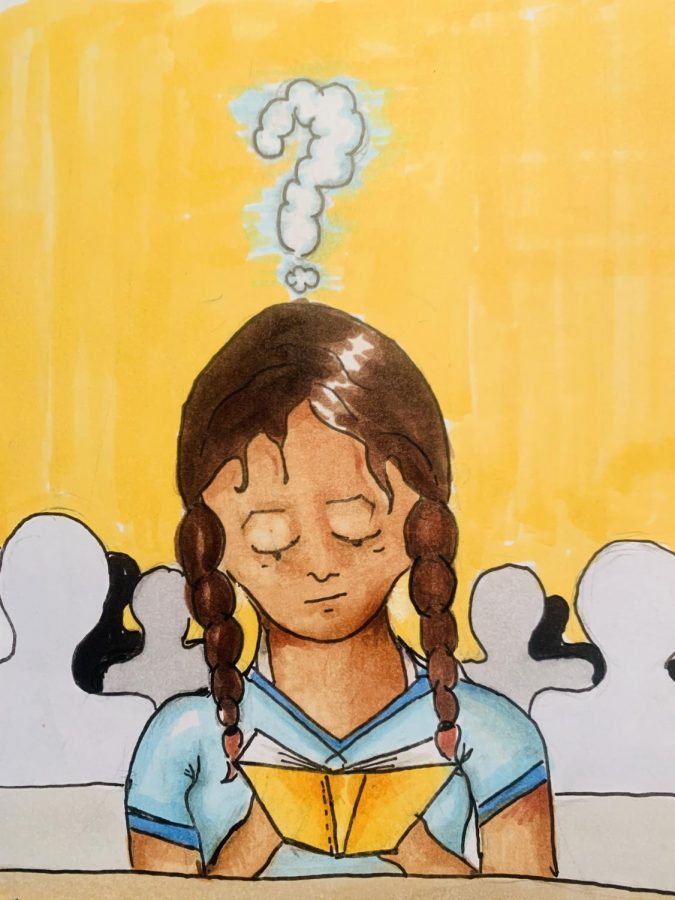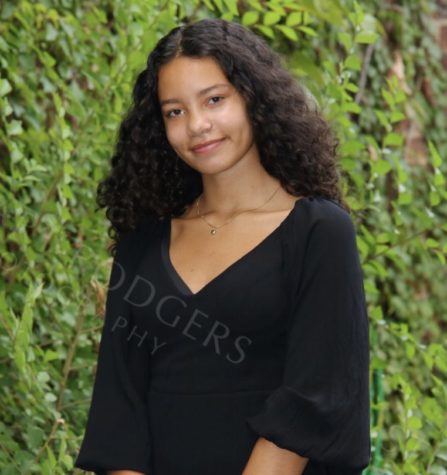How English Language Learners experience school
December 13, 2019
Evanston is known to be a very diverse place, with our student population varying in cultures and nationalities. According to the Illinois Report Card, ETHS has 5.2% of English language learners, which while lower than the Illinois state average, is a significant portion of our school population: nearly 200 students. Communicating, a seemingly simple thing, can become difficult for these non-English speakers.
With this range of languages spoken amongst the student body often comes language barriers. Merriam Webster defines a language barrier as “a difficulty for people communicating because they speak different languages.” This phrase includes the term “barrier” because it limits the way non-English speakers can express themselves. They become confined by this barrier unless provided with the resources to communicate and learn. Understanding and being able to communicate in English is a key skill in the classroom, and though English speakers don’t think about it as they grasp the information spewed at them, some of our peers may find themselves lost in the complicated language. This can prohibit and slow down their vocabulary and language acquisition skills, as well as possibly prevent them from participating, socializing and learning in these environments. I know, I’ve been there.
I grew up in Sweden. I lived there for six years before moving to the United States when I was about six years old. I was fluent in Swedish and was gradually learning a little bit of English. However, when starting first grade, the first thing I noticed was that I couldn’t express myself as easily as my peers because I struggled with English. While my peers were holding full conversations with ease, I was still using flashcards to learn simple words. I could recognize certain words, but not the way my fellow first graders could. Sitting there, not having a clue what your teacher is trying to tell you, is one of the most isolating feelings. You don’t know much to begin with, and are put in a class far beyond your basic abilities.
Sophomore Kassim Limane, who is from the Central African Republic and primary language is Sango, explains his experience with the English language before moving to the U.S. “[Before moving to the U.S.] the only thing I knew was good morning and the numbers one to ten,” says Limane.
He goes on to explain the difficulties of communicating with those around him when first moving here. “[I only communicated with] the people I know who speak the same language as mine, so communicating in French or Sango. And my teachers, I used google translate to communicate with them,” Limane says.
Language barriers are something many people have to deal with every day. There’s so many different people with languages in the world that sometimes communicating isn’t always as easy as some may think. Due to this, many resort to not talking at all, or when they do decide to speak up, if they have an accent, will struggle with feeling judged.
When asked about how he feels about communicating with those around them, sophomore Tepmontree Rattanawit explains, “I feel great, but sometimes I’m tired and confused about English language because when I speak English, I have problems with the accent. My language didn’t have some characters such as s ,h, ss, ch, and sh. We didn’t use the sound.” Rattanawit moved to the U.S last October, and his first language is Thai.
The transition of learning a new language can be stressful, and for English language learners such as myself, classroom activities like small group discussions can be difficult, so the support of a teacher and peers is crucial for a student’s sense of belonging and academic success. Without this they often shy away from expressing themselves.
Freshman Daniella Grant, who moved to the U.S. from Jamaica when she was only four years old, explains her experiences with ESL (English as a Second Language) classes at Jordan Community School, her elementary school. “[The ESL classes] were positive, but I did wonder at times why other students weren’t doing this because I didn’t really see other students, so sometimes I felt like I was different from them. I would always try to fit in, like sometimes I would try to not have my accent. Now I embrace where I’m from,” says Grant.
The process of understanding the language differs for everyone, and with that comes the need to also read, write and speak it. In earlier years of education, there were often classes for students to learn and catch up to their peers with the English language in K-8. According to an NPR study by Claudio Sanchez, “ESL stresses simplified speech and uses visual or physical cues, memorization and drills. Instruction is all about getting kids to function in English as quickly as possible and spend little time on a child’s native language.”
“They’d ask me questions, they’d have me read stuff from a book, and they’d make me listen to stuff and sometimes translate it. They were very friendly and I was supported. There were other people from Jamaica but not that many. I still made friends easily,” Grant explains.
Throughout my elementary experience after first moving to Evanston, I was also pulled into a seperate class for ESL speakers. I went to Lincoln Elementary School, and this class was formed of a few other English learners, a small community within the fairly large elementary school. This gave me the opportunity to sit down with a teacher and go over the English language in-depth, and even make a few friends. Though I wasn’t caught up with those around me who had started the class in kindergarten, this class quickly made me become more comfortable with my English. After taking the class for about four years, I remember the joy I felt when the teacher told me I no longer needed the class, a huge accomplishment for my fourth grade self.
A similar program can be found here at ETHS as well: the Bilingual Education program. This program is working to help non-English speaking students as they begin to learn English. According to the ETHS website, “The Bilingual Program is designed to meet the needs of students with limited language fluency in speaking and understanding English. Students have the opportunity to learn English as a second language (ESL), with emphasis on reading, writing, listening, and speaking, and become familiar with American culture and institutions as well as those of their native countries.”
Within these classes remains the range of student abilities and skills, which is based on the students prior knowledge on the language. While some may not have seen a letter before, and others can read but not write, the background they come from determines how they move through the program.
“In the Bilingual Program the students themselves are EL’s, and the class they’re taking is English as a Second Language. We have lots of different classes that we offer. We have ESL 1, 2 and 3 and they are both two period classes; one period is devoted to reading and one is devoted to writing. Students can transition from ESL 1 to ESL 2 or ESL 2 to ESL 3 in the middle of the year or semester. The classes are offered at the same time so they can schedule change without a problem,” explains Rachel D’Onofrio the Bilingual Education Program Department Chair.
Some students also receive instruction by native teachers in their own language, and receive individual tutoring and counseling for all courses in the total school program. This helps the student build confidence, and the program is flexible around the students’ intellectual ability and scholastic achievement. ETHS paraprofessionals also support students in classrooms. There are currently four paraprofessionals in Bilingual Education program, and about 60 students in the program.
“I take English ESL class. Without ESL classes, there’s no way that I’d speak English. English ESL classes help me a lot; I don’t feel different when I am talking to other students in English. I would like to thank all my English teachers,” says Limane.
However, the ETHS community is still working to transition smoother for non-English speakers.
“I took 2 ESL [classes] in ETHS, two classes of a day. I think that was good, but it is kind of slow for me to learn. I think sometimes I need more lessons and faster lessons. I wasn’t born here, so that means we should have lessons that are important for us. I’m happy to stay here, but I need classes to help me prepare for university in the future,” Rattanawit explains. “However, I like ETHS here, it has a lot of activities to do and all of the teachers are very nice to me. They helped me a lot. The important thing is language because all of the works are English language.”
Non English speakers also rely upon building relationships with other staff in the school and their English speaking peers. The Bilingual Program has done a great amount of work to insure non English speakers have the resources to succeed and feel welcomed in our community. According to the Illinois Report Card, 4.6% of students who completed bilingual education and were ready for integration into regular classes, joining their peers who will continue to make the transition more effective and positive for them.
“The structure overall has been the same within the eight years, though it has expanded. We’ve had better collaboration through different departments, not only academically but also student services like the nurses office. My favorite thing when I talk about this program and what brings me the most joy is people don’t call them your kids, meaning mine, they call them our kids. Like, its collective ownership of ‘ let’s make this a better, more welcoming place for our school,’” D’Onofrio explains.
Though many native English speaking students and staff may not realize, what D’Onofrio describes is echoed by other English language learners such as myself. As the Bilingual Program continues to improve and work to welcome non English speakers, the resources provided through this program are a tremendous help available for non english speakers, and have shown signs of success.
Limane describes the environment our ETHS community must make sure to give all non-English speakers.
“If I have a problem, I always talk to my teachers about it, and they always do something about it. Most of the students at ETHS are very kind, they help me a lot. Especially in my math classes, I always have 80 percent of the students help me with explanations and other stuff,” he says.










